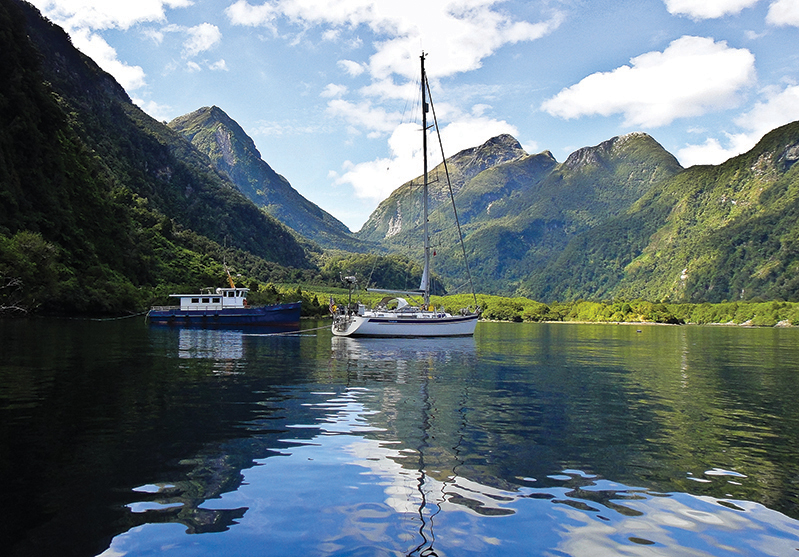A leisurely cruise in Fiordland, New Zealand (published January 2013)
“You’re going where? Why? Just rent a campervan and drive there!” That was the response we got from most people when hearing our plans to sail around the South Island of New Zealand.
Indeed, South Island has a well-deserved reputation for intense and sometimes quite nasty weather. Storms barrel across the Tasman Sea on a furious mission to scour the western coast. Steep, large, dangerous waves rise rapidly and—combined with storm force winds—will wreak havoc on any boat caught out.
My husband, Jim, and I did the campervan thing last year and had a fantastic time exploring the ruggedly beautiful South Island. Our tubby little land yacht always made a beeline for harbors, bays and lookouts along coastal roads to assess the seas. Could we sail here? The possibility loomed large. Noonsite, which doles out advice about sailing around Cape Horn, recommends driving around South Island. Undeterred, Jim sent messages to both Jimmy Cornell of Noonsite and Ken Campbell of Commander’s Weather for their input.
Jim,
You are absolutely right—if you have plenty of time (which most people don’t) sailing around South Island by watching and waiting for good weather is the way to do it. I wish I had done it myself!
Good luck.
Jimmy (Cornell)
Hi Jim,
Jan./Feb. is the best time of year to do that trip. Yes, we have worked with many clients and your plans are exactly correct other than Feb. is just as good as Jan. Just have options for stopping if the weather is bad, but I have seen highs set up over S Island for 7-10 days during those months, so the weather can be very nice. Hey, they always say summer in NZ does not start until Christmas!
Kind regards,
Ken Campbell
This trip seemed like the perfect opportunity to take a step forward in our sailing lives, increase our knowledge, improve our skills, and visit spectacular places only accessible by boat.
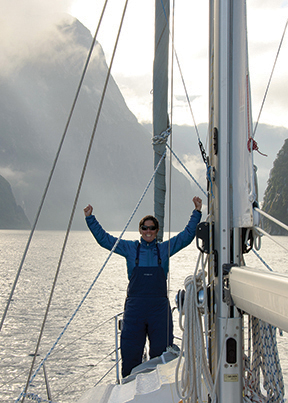
GOLDEN BAY & MILFORD SOUND
With a bit of trepidation, we tossed off the dock lines in the Bay of Islands and headed north around Cape Reinga, the tip of North Island, and down the western coast. We would sail all the way to Milford Sound if the weather held. If it deteriorated, the plan was to duck into Golden Bay at the top of South Island and wait.
It seems Mother Nature wanted us to visit Golden Bay and the scenic Abel Tasman National Park. As we approached Cook Strait, she began to huff and puff and stirred up a menacing brew, which convinced us to take refuge. We spent 11 days exploring this gorgeous area before she was satisfied that we were duly impressed and allowed us to continue on to Fiordland.
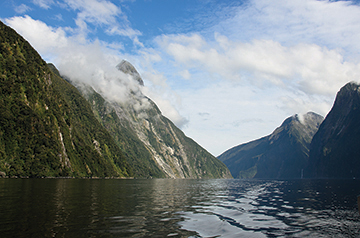
Five days later, dawn broke as we floated outside the entrance to Milford Sound. The air was cool and without a breath of wind as Tenaya motored in past the overlapping headland. Misty clouds hung on the shoulders of tightly clustered, towering peaks and gathered in the folded valleys of a dramatic, eerie, monochromatic grey landscape. Waterfalls poured down vertical walls and spilled from classic U-shaped hanging valleys where we felt the spray as Tenaya closely passed Stirling Falls. In the shadow of Mitre Peak, which rises 5500 feet directly from the sea floor, we were reminded of our own insignificance. What a spectacular place! We were thrilled to have arrived under our own power.
Only two sounds are accessible in Fiordland, and Milford is the most popular. Arriving by car, bus or plane, 500,000 people visit each year. We were keen to move on to more secluded areas, but before we did, we prepared the boat for what lay ahead. A dozen bottles of 98% DEET were put in a handy location along with mosquito netting covers for all the hatches. Two bags containing 300 feet of line each were fastened to the base of the shrouds on both port and starboard sides. Our new kayak was inflated and lashed to the dinghy already mounted upside down at the bow. The paddles were assembled and tied to the coach roof, as was a fender with 100 feet of line to be used as an anchor buoy. Four diesel fuel jugs were secured behind the dinghy and the storm jib remained fixed at the bow. Our normally tidy girl looked like a yard sale, but she was ready to head further south in the Roaring Forties.
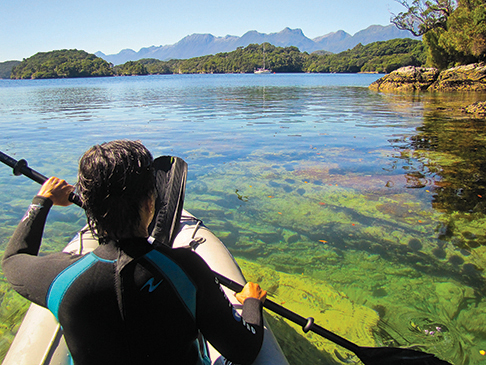
Fifteen fiords, mistakenly named sounds, make up the vast Fiordland National Park located in the southwest corner of South Island. Those in the north are narrow and steep-sided, with dramatic peaks rising out of the water to lofty heights. Those further south are lower, with wide-open mouths. There are bays in some, islands in others. Several have long, narrow arms branching out. As far as the eye can see, a blanket of dense forest covers the mountainous land. Harsh weather, more than 22 feet of rain each year, and tiny but vicious sandflies have kept human habitation at bay. We spent a month in this remote, magical area exploring Milford, George, Thompson, Bradshaw, Doubtful, Breaksea and Dusky Sounds. None are more than a day sail apart. We chose those fiords with safe, all-weather anchorages. Yes, the word fiord is spelled with an “I” here.
GEORGE SOUND & THOMPSON SOUND
We left Milford Sound in the stillness of the morning fog and motored 25 miles south to George Sound. As we made our way toward the head of the fiord, the sky gradually cleared and became a brilliant blue backdrop for big, white, puffy clouds. On either side of us rose tall mountains until we turned into Alice Falls, a small, pretty cove adjacent to a waterfall.
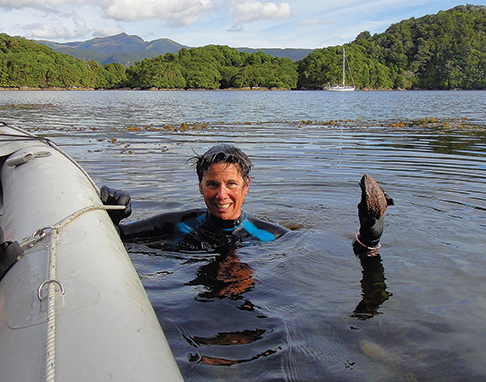
Once the anchor was set, we eased the kayak overboard. In a move that would become familiar, I paddled a line out from the most vulnerable side to secure the stern. Then I returned and got a second line from the opposite side, paddled it out, and secured it. Here, as in several places in Fiordland, a line was strung across the narrow cove. I simply tied through loops in it. Later, in different anchorages, I would have to tie the lines to trees ashore. At low water we hopped into the kayak for a paddle to explore the shoreline. Even then it was possible to paddle right next to the steep walls and overhanging vegetation. Around one bend we found heaps of mussels hanging from a partially submerged limb. Guess what was for dinner that night?
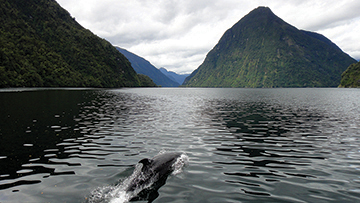
The reflections of the mountains and early morning sky on the glassy water were surreal as we slowly eased out of the anchorage the next morning. Thinking that life could not be any better, something splashed in the distance. Dolphins were coming to visit! They frolicked at the bow for half an hour, darting back and forth, gliding close to the surface and arching out of the water. From my perch on the bow I cooed and cajoled as they passed, often looking up at me. A juvenile was especially endearing. Numerous times it rolled over to reveal a white belly and several times rubbed its small body on the bow while drifting on its back. The inquisitive creatures only left when the water began to ripple.
We continued south to Thompson Sound, which is part of the Doubtful Sound Complex. A boat can travel more than 100 miles in these protected waters with a variety of safe anchorages. We spent over two weeks exploring this spectacular area. At Precipice Cove, near the head of Bradshaw Sound, a charter fishing boat pulled up next to us one night. On his way out the next morning he tossed a bag of spiny lobsters onto our deck. Cheers, mate!
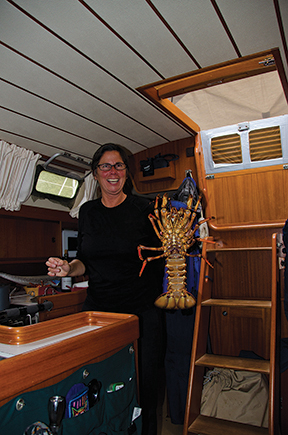
BREAKSEA/DUSKY COMPLEX
With 20 knots on the nose and pelting rain, we made our way down Doubtful Sound to the Tasman Sea. The image may suggest misery, but rain in Fiordland brings the mountains and forests to life. Hundreds of waterfalls flow like white ribbons draped over gigantic rumpled green gifts, and the wind reminds you of where you are in the world.
It was a fast and fabulous sail 20 miles south to Breaksea Sound, the entrance to the Breaksea/Dusky Complex. The cloud resting on the sea spent the day reeling in and out the visibility and showering us with rain. As we approached, it cleared to about one mile and the wind kicked up over 30 knots. With sails rolled into tiny pennants, we were still making 5.6 knots through the rocky entrance.
Southern Winds, the green Department of Conservation boat with dolphin researchers on board, had left Doubtful Sound behind us, quickly passed, and was now hovering just inside the protected waters. It was a reassuring sight. As we neared the head of Breaksea Sound, we were again joined by bottlenose dolphins who escorted us to the anchorage. The researchers on Southern Winds waved and cheered as they saw our companions at the bow. They, and one other fishing boat, were all we saw that day.
Meri Leask runs Bluff Fisherman’s Radio and has daily SSB schedules to contact and keep track of the handful of fishing and charter boats in the waters of South and Stewart Islands. She encourages yachts to participate. We and the six other yachts south of 44°S checked in each evening. In this remote area, it was comforting to know someone knew of our whereabouts. The skippers of the boats we met were friendly, helpful, and unassuming, often sharing their catch with us.
The Breaksea/Dusky Complex is another combination of interconnected fiords where boats have more than 100 miles of refuge from the turbulent seas outside. Dusky Sound is the longest at more than 26 miles and was named Dusky Bay by Captain Cook as he passed by late one day during his first voyage to New Zealand. Indeed, the entrance is wide with many rocky and wooded islands. It is a beautiful area with several safe and beautiful anchorages.
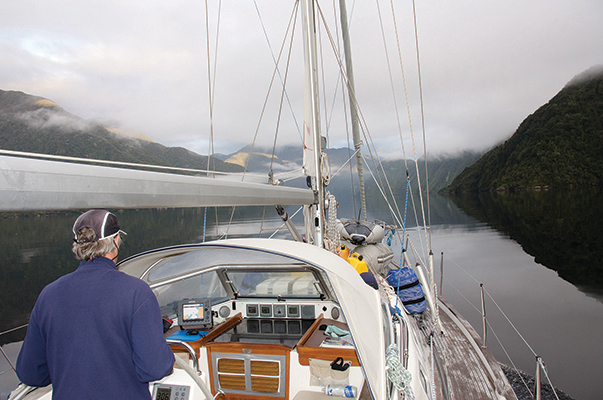
Outer Luncheon Cove was a favorite of ours. It is a calm patch of water surrounded by islands. For some reason, the bothersome sandflies, which are found in abundance everywhere else in Fiordland, do not exist here. How nice it was to lie in the sunny cockpit or paddle around wearing nothing but a swimsuit! NZ fur seals frolic in the water and barely took notice as we passed in the kayak. I snorkeled for paua (abalone) and we collected dozens of mussels. We took wonderful hikes, including one at Anchor Island, a bird sanctuary.
Another great place was Pickersgill Harbour, named by Captain Cook for the lieutenant on his second voyage to New Zealand. We may have even tied a stern line to the same horizontal tree he did 239 years ago! While anchored and tied up in the snug cove, a charter fishing boat pulled up and asked if we like crayfish. “Yes!” we exclaimed. In no time, a bin filled with five prickly crustaceans was handed over the lifelines. Our buckets and pot were wholly inadequate for their large size, and I fumbled as they tried to escape, but we managed to cook and devour each one.
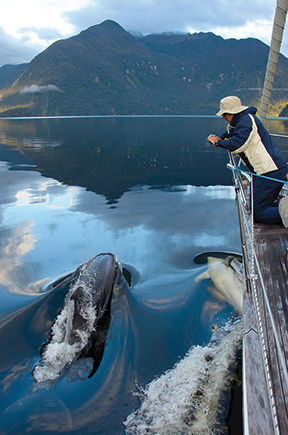
We were lucky with weather during our time in Fiordland. Yes, it rained a few days, we had some fog, and the wind outside blew at gale force as often as not, but we were safe and comfortable inside the protected coves. We are pleased that we allowed enough time to travel only in good weather. If in doubt, we waited and enjoyed the special place we were, savoring the solitude and appreciating the beauty. It was difficult to leave majestic, pristine Fiordland, but we wanted to sail further south. Eventually a weather window opened up for the overnighter to Stewart Island and we headed off.
Katie Thomsen was living in Antwerp, Belgium when she returned from a kayaking trip in the scenic waters off Vancouver Island, BC and announced, “I could live on a boat.” Two years later, that’s precisely what she and Jim were doing. It took a full season and 50 hours of private lessons before Katie felt comfortable handling Tenaya, the couple’s 2006 40-foot Hallberg-Rassy sloop, in the protected waters of Zeeland, the Netherlands. Katie and Jim sailed into the North Sea, down the Atlantic coast, into the Med and across the Atlantic. After sailing up and down the Eastern Caribbean they crossed through Panama and into the Pacific. Six years and 30,000 miles later, Katie continues her quest to improve her sailing skills by venturing into higher latitudes while delving deeply into the lands and cultures she encounters.

















